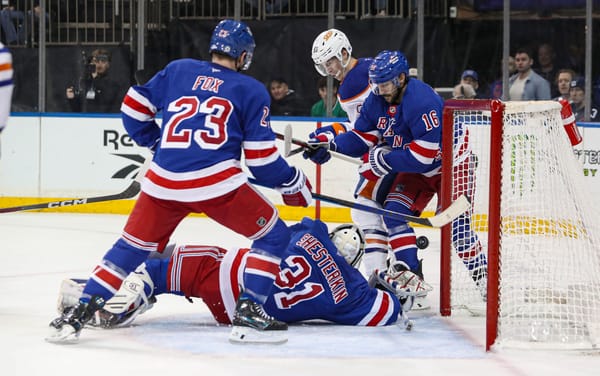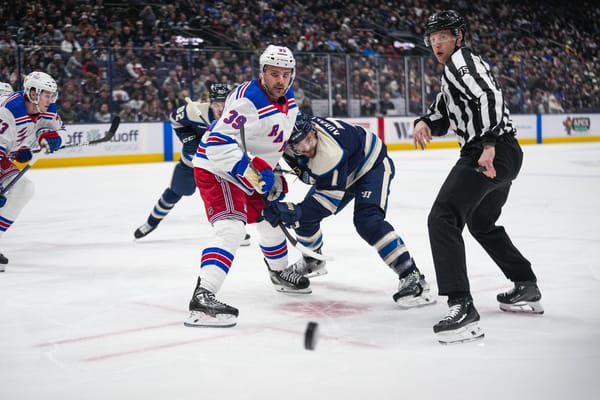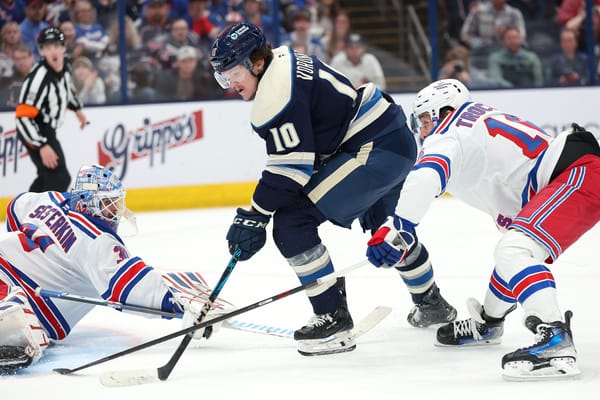How Rangers Can Improve Toughness This Summer
By addressing aggression this summer, New York’s new philosophy can be a year-one success.
No professional sports team, let alone one in the NHL—a league renowned for and prideful of its bravado—wants to be branded as easy to play against. To suggest that a group might be seen as something of a night off for their opponents is tantamount to questioning the integrity of each of the players who call that team home. Yet, last season, the New York Rangers were an easy team to play against.
Lacking any discernible identity, the Blueshirts struggled to find their game and exact their will against opponents as they had in years prior. They suffered for it. By the turn of the new year, things had gotten so bad, they found themselves routinely playing against backup goaltenders – a strong message that opposing teams no longer feared them.
Both scoring and defense were major problem areas, but so too was the lack of toughness for these Rangers, whose one-on-one play, puck pursuit, and physical game left much to be desired. Though their hitting numbers were stable relative to Alain Vigneault’s tenure as head coach, on the whole, “beating” the Rangers on any given night wasn’t a terribly difficult task for opponents. They could be hemmed in their own end for extended stretches, were prone to giving up the lion’s share of high-danger chances against, and could be forced into coughing up the puck when subjected to a strong, sustained forecheck and/or physical play in man-on-man puck battles.
Let’s Get Physical, Physical
Improving physicality has been mentioned by the Rangers’ front office since Vigneault was let go and was referenced on two separate occasions by new head coach, David Quinn. When asked recently by New York Post columnist Steve Serby what his definition of physical toughness was, Quinn answered tersely with “someone who can take a hit to make a play.”
In the wake of similar comments from Quinn regarding wanting his team “to be in the opposition’s faces,” made in his ‘Letter to RangersTown’, the new bench boss again elaborated with Serby on what this sense of physicality should look like on the ice:
“Getting to people quickly and making them uncomfortable, because sometimes the size disadvantage isn’t going to allow you to be physical on everybody,” Quinn responded. “So if I’m 5-foot-10, 185 pounds, and I’m going up against someone 6-4, 225, I don’t want you wasting energy and trying to be physical with somebody who you’re going to lose the battle no matter what. If you’ve got the ability to be actually physical with them, do it.”
Given the immediate allusion to size disparity, what Quinn appears to be speaking to here isn’t the kind of toughness that’s become an anachronism in today’s NHL – a game now largely defined by its speed and skill. Rather, what he seems to be after here is the embrace of a new understanding of toughness in the current climate. One that strongly favors relentless puck pursuit and targeted aggression – elements that aren’t absent in today’s game but were largely missing under Vigneault’s tutelage. While some of that fault can be attributed to AV’s coaching philosophy that favored shot selection over volume, physicality was always a concern under his watch.
“We want [the opposition] to know when they see the Rangers on the schedule, it’s going to be a long night,” Quinn added in his letter to the fans. “We’re going to play with the puck, and the minute we don’t have it, we’re going to work to get it back. Whether in our zone, their zone or the neutral zone, our job is to make things as difficult as they can be for the 20 guys in the other uniform.”
Despite their dismal finish to last season, Quinn’s new strategy is achievable without the need for massive roster turnover. It could even be highlighted by a few of the Rangers’ young veterans – particularly straight-line players like Chris Kreider, Jimmy Vesey, and Jesper Fast.
However, it might behoove the Blueshirts’ front office to ensure enough of this “character” is under contract next season to give their new coach his best fighting chance. If they plan to be as active in trade talks ahead of and at the draft this June as they’ve lead us to believe, it’s possible that one or more prototype, workman-like players such as Mats Zuccarello or Kevin Hayes could be moved in trades. Doing so would open additional holes that would need filling before training camp begins.
While the unrestricted free agent market doesn’t appear overly promising, the Rangers do have options—in it or through trade—to improve their rebuilding efforts and to give Coach Q a team he can proudly call his own.
Finding “Fight” in Free Agency
Perhaps Scott Hartnell, 36, could be persuaded to pull on a blue shirt? The veteran, known for his leadership qualities and strong physical play, is a rare combination of adept hockey player and tough leader. Though he only made it into four of the Predators’ playoff games this postseason, his presence—primarily physically—was felt in each of them.
Hartnell is an example of a player who is "good in the room" but also will do good hockey things on the ice.
— Adam Herman (@AdamZHerman) June 29, 2017
For a Rangers team whose leadership was heavily scrutinized after last season, Hartnell could check more than one box on their summer wish list that as we’ve known since April, already includes improving in general toughness. In fact, he could be distinctly valuable in helping to bring along a youngster like Lias Andersson, who also plays with a physical edge, while helping him navigate potentially treacherous waters on a team that may not be very good. Though one wonders if he can improve by taking fewer penalties game-to-game – an issue he’s struggled with his entire career. In a recent 31 Thoughts column by Elliotte Friedman, Hartnell offered some insight on what his next move could be.
“Me and my wife have talked about it, our son isn’t in school. If there’s a team that’s the right fit for all of us, we are 100 percent going,” Hartnell said, speaking to what the future holds for him.
Given his age and the fact that Nashville chose not to offer him a return contract, New York wouldn’t be out of their depth to offer a similar deal to the one he signed last year. Something in the vicinity of one-year for $1.75 million. Though it may seem odd to offer a declining veteran that much money for a reduced role, it’s important to remember that the Rangers could very well miss the playoffs for a second-straight season, so for potential free agents, dollars, more than playoff promise, will likely be a motivating factor in any deal.
Many, many people will pay for NHL teams this coming season and contribute less than Scott Hartnell could. pic.twitter.com/aop7dof0nO
— Micah Blake McCurdy (@IneffectiveMath) June 29, 2017
While he’s probably eyeing another shot with a contending team out of the gate, it may prove difficult to find a willing dance partner this July with more and more NHL clubs embracing youth movements. Signing with a rebuilding team could be seen as a step backward but could also be a prudent two-pronged solution on Hartnell’s part. If the Rangers make the playoffs as a chippy wild card, great. Maybe they make a go of it. Or, should they fail to qualify for the postseason, a one-year term would grant both Hartnell and the team a sort of insurance policy that could see Hartnell traded at the deadline for additional assets, giving him another kick at the can with a playoff-bound club.
Another unrestricted option for Rangers’ general manager Jeff Gorton to consider is 28-year old Antoine Roussel. The hard-working, in-your-face-type is a pest who plays a heavy 200-foot game despite his middling 6’0, 200-pound frame. On paper, he could fit Coach Q’s preference to a tee. Like the trade that brought Wayne Simmonds to the Philadelphia Flyers years ago, unleashing number 21’s brand of antagonism on the Metropolitan division might be a worthy cause for the Rangers to try their hand at.
Roussel is coming off a down year – his second-worst by way of production since he joined the league in 2012-13. Yet his five goals and 17 points in 73 games last year could actually help in keeping his annual average value (AAV) manageable. Between 2013 and 2017 he averaged 13 goals and 28 points per year and has always performed well in all three zones. Including last season, he’s never owned a Corsi for percentage south of 50.7 or a Fenwick for percentage below 51.1. And only once in his career (2015-16) was his PDO north of break even (101.5), suggesting he’s a consistently reliable even-strength performer.
According to Matt Cane’s 2018 Free Agent Predictions, Roussel projects to earn just shy of $2.5 million per season on a four-year term, which would be a slight raise on the $2 million AAV of his previous deal. Though four years might feel a year longer than a desirable term for the Rangers, if Gorton can keep his AAV south of $3 million, the extra year is unlikely to become a hindrance. It may even be plausible to snatch up the French-born winger in under-the-radar-fashion should the higher-profile Ryan Reaves make it to market this July. If he’s heavily courted by other GMs, Gorton might get the edge he needs to entertain a “consolation prize” like Roussel.
Or, if not Hartnell or Roussel, the market could also offer additional options at forward such as 30-year-old James Neal. The power forward would bring a valuable combination of high-end scoring and superior physicality but promises to sign a lucrative, long-term deal. Entering the first full season since the decision to rebuild was made, it’s questionable if the Rangers should be entertaining these types of contracts just yet.
There’s also the aforementioned Reaves—who is also likely to sign a regrettable deal—as well as veterans like 28-year-old Matt Calvert and 31-year-old Leo Komarov who could be considered.
On defense, 29-year-old Ian Cole, who always plays with a physical edge, might help to eat minutes and can be deployed with heavy defensive zone starts. So could 27-year-old and soon-to-be ex-New York Islander, Calvin de Haan. Neither player stands to break the bank in the process. Again, according to Cane’s salary projections, the former should earn just over $3 million on a three-year ride. de Haan, on the other hand, is coming off a season-ending shoulder surgery that limited him to just 33 games. He stands to sign something of a prove-it-type one-year, $1.6 million ticket.
Trading for Today’s Truculence
If for whatever reason the Rangers find themselves priced out on or uninterested in the small collection of quality free agents that could be available to them this July, there’s always the trade market to explore. Someone like 25-year-old Ottawa Senators forward Jean-Gabriel Pageau—under contract for two more years at $3.1 million per season—could make sense to inquire about. So could Minnesota Wild RFAs Matt Dumba (23) and Jason Zucker (26) – the latter of whom picked a great time to have a career-high 64-point season. The Wild may have cap-crunched reservations about committing to him, in which case, the Rangers would be smart to inquire about his availability.
On Pageau, the Blueshirts could even get a little funky if they’re being honest about how long this rebuild will take. By offering to accept a bad contract in return, they could mitigate the cost of acquisition on an otherwise valuable player like Pageau who has scored 45 goals over the last three seasons. The Sens happen to have two interesting names of note here: the permanently-on-LTIR Clarke MacArthur, who has two years left at $4.65 million per, and ex-Ranger Marian Gaborik, with three years remaining at $4.875 million. This is also what salary retention was designed for.
The Wild, now lead by new GM Paul Fenton, are in a pretty serious salary cap crunch, so prying out either Dumba or Zucker would likely cost the Rangers in picks and/or prospects. Before you bristle at the idea, remember that with respect to the picks, Gorton himself has admitted he’s not afraid to deal from the small fortune of them his team owns this year to acquire talent.
There’s Always the Draft
Lastly, assuming he’s still available by the time the Rangers pick with the ninth selection or if a deal is struck to acquire a higher pick in order to take him, there’s also Brady Tkachuk to keep in mind. Ranked ninth by BlueshirtBanter’s own Adam Herman, the 18-year-old Boston University product comes with plenty of physical promise, much to the same degree—if not more—that Calgary Flames fans have witnessed for the last two years watching his brother Matthew since drafting him sixth overall in 2016.
Tkachuk is in a lot of ways exactly what one would imagine the son of Keith Tkachuk might look like as a hockey player. He’s a big, strong power forward who can bully players and use his strength to shield the puck.
It’s fair to question if taking Tkachuk too early at the draft would constitute a mistake, especially if more talented options are left on the board in doing so. His draft rankings vary some but could see him go as high as third or fourth overall. But what need not be questioned is whether the Quinn-coached Terrier would bring a level of aggression and hostility that would speak directly to the front offices’ desire to improve team swagger. The youngster would surely represent, if not spearhead, an emphatic cultural shift away from AV’s adherence to the Gospel of Matthew towards Quinn’s demand for targeted aggression.
But regardless of whether Tkachuk is their guy or not, the shift is coming one way or another as the Rangers prepare to enter the dawn of a new era designed to reinstate the confidence the club lost under the direction of their former coach. Quinn has been charged with making right on this change in philosophical direction and given the task of returning the Rangers to the league’s elite contenders. How quickly he can make meaningful progress on the matter, however, could hinge on how deftly the front office traverses their offseason terrain, specifically regarding Gorton’s desire to improve team toughness.
It’s premature to make accurate assessments about what kind of damage next year’s Rangers can realistically do. We simply don’t have enough information yet, and won’t until at least the second day of the draft. But hard-working teams (hello, Vegas) have a knack for surprising people. So, provided the lack of toughness issue is properly addressed this summer, there is one thing we can count on next season: win or lose, the New York Rangers certainly won’t be easy to play against. And that’s progress of a kind en route to contention.
All stats via Corsica.hockey unless otherwise noted. Financial information via Cap Friendly unless otherwise noted.




